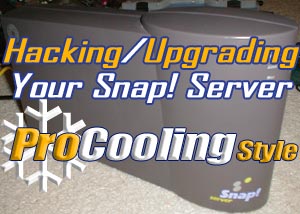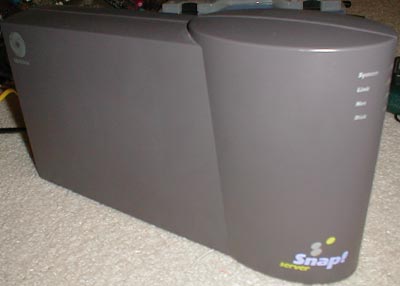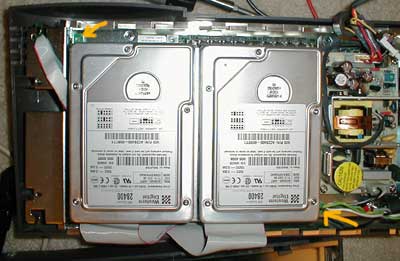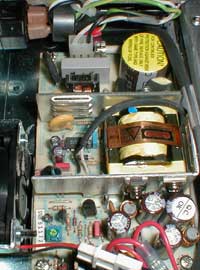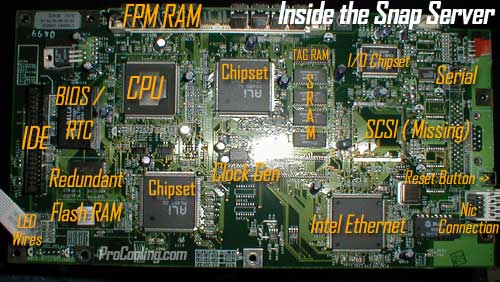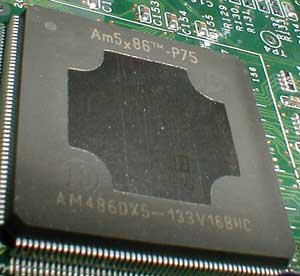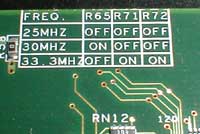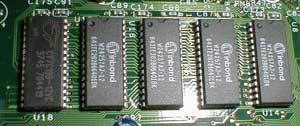|
|
|
|
 Hack a Snap Server Hack a Snap Server
|
|
Date Posted: Oct 16 2001
|
|
Author: Joe
|
|
|
|
|
Posting Type: Article
|
|
Category: Hardware Modding
|
|
Page: 1 of 2
|
Article Rank: from 2 Readers
Must Log In to Rank This Article from 2 Readers
Must Log In to Rank This Article
|
|
|
|
|
Note: This is a legacy article, imported from old code. Due to this some items on the page may not function as expected. Links, Colors, and some images may not be set correctly.
|
|
|
Hack a Snap Server By: Joe
|
|
|
|
|
|
WTF is a "Snap!" Server??
A Snap server is a NAS device ( Network Attached Storrage) that was introduced by Meridian back in late 1997. They called it a "Networked Harddrive", and for all intents and purposes it is that. Soon after Meridian's' rollout of their Snap! servers, Intel and many others released their competing products that do the same thing. What they do is, you plug them in and over a TCP/IP stack, NetBIOS, NFS, AppleTalk, or Novell Networking you can access them as a network share, giving you a fairly rapid increase in disk space on your network.
|
|
|
In concept it sounds too good to be true, but then you check the price tag and see that a 10GB device back then was costing almost 1000$, with a 5GB down around 500$. That is the main reason you prolly haven't heard of a "Snap!" sever. They were priced WAY out of reach for the general public, also they were fairly slow over the network compared to local storage.
With storage prices crumbling ( HD's, Ram, DVD-R, CD-R) These servers have for the most part left the home user arena and centered on where they CAN be used and where the money is, Enterprises. Meridian was bought out by Quantum around the time this change happened. So all the Snap servers became "Quantum Snap Servers". They now produce Storage solutions from the "low" size of 20 GB to a Terabytes of scaleable storage. But they are still extremely expensive for the size you get. This brings us to why we are Hacking and Upgrading.
UPDATE: 3/10/02 It seems Snap 1000 boxes are not the same as the others. They may hold parts of the OS on the disk. SO you can install a second disk but not replace the original one that's in it. JUST FYI! Check this thread in the Pro/Forums where people are discussing this right now.
|
|
|
|
|
Why Upgrade?
|
|
|
It's all about getting more for your money. Like back in the ProCooling iOpener articles ( here) and ( here ) you take a product that a company sells, and exploit it to get more for your money or work for your specific use. This is very much the same as overclocking, but we are OC'n the storage space and not the CPU ( unfortunately).
The Money aspect. As I said before, these things are brutally expensive and this is most likely the reason there has not been an article about this on the web yet, cause everyone is SO afraid to open and break these things. Here is a price comparison :
|
|
|
|
|
Device / Disk Space
|
15GB
|
30GB
|
80GB
|
160GB
|
|
Snap! Server
|
485$
|
733$
|
1149$
|
2110$
|
|
Ultra 160SCSI
10kRPM HD
|
105$(18.2GB)
|
230$ (36.7GB)
|
443$ (74GB)
|
1348$ (181GB 7200RPM)
|
|
ATA 100
7200 RPM HD
|
76$(20GB)
|
95$ (30GB)
|
169$(80GB)
|
2x 80GB = 338$
|
|
|
Now you can see compared to IDE or even the premium and top performance SCSI, the Snap! servers are 1000$ more expensive in some areas. Now if you were shopping around and saw the 15GB device listing for close to 1800$ cheaper than the 160GB you would prolly want to buy the 15GB instead and then buy 2 80GB HD's and put em in the 15GB server Right!.... well I did ;)
|
|
|
|
This is my rather old and humble Snap! server, it has 2 7.5GB IDE HD's insides giving it 15GB of total storage.
For the longest time I though that they kept the OS (Linux) on a header partition on the HD's so I never wanted to touch it to upgrade for fear I would kill it. This is more than likely the same reason no one has wrote this up yet. There is no way to get "into" the devices OS that I have found so I was not able to find where Linux was sitting on the machine. I tried Telnet but no one was home. As you can see there is no console port or anything.
|
|
|
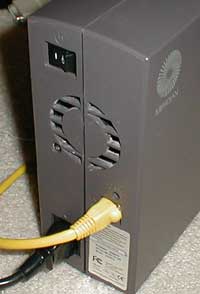 |
|
|
|
|
|
Once opened all you see are the 2 HD's bolted to a removable plate, this was a good sign, it looked like it was made to be swapped out by the Meridian techies if they needed to fix something on an RMA. Remember folks, when you go into something like this think about what the company may have done to save money on RMA repairs or failure rates. With that in mind I figured that the OS could NOT be on the drives. No company would want to be faced with a reload of their core OS in the face of a drive failure. So I was on a manhunt for the rest of the secrets in this thing. I took the HD panel off and set it off to the side. and noticed the entire chassis just comes out without any issue.
|
|
|
|
|
|
|
 |
|
|
There you can see the Mobo bolted right underneath the metal chassis and PSU. The PSU itself is real small, puts out 12v and 5v and 3.3v. It controls the powerup and shutdown of the mobo itself. the switch is not a hard cut on the 120v. So when you power it off the OS is triggered to unload and when that's done the machine powers off. Sorta like windows and ACPI, but a much more old school implementation.
What's that I see?? FPM ram! People please put your chairs in the locked and upright position, cause we are about to take a trip down nostalgia lane.
|
|
|
This is the main board in all its splendor. This is a true no moving parts full computer right here. Lets break down some of the more interesting parts now:
|
|
|
|
This is a Snap! server of 1998 Vintage... a good year. :)
|
|
|
|
|
|
The Main CPU
YES! a 486! For those of you who have been around since back then and before, know this chip. This chip is covered in so many great old terms I have almost long since forgot like "P##" Numbers, and AM486DX#, and the Infamous Am5x86 ( only one more notorious is the NexGen Nx86).
This is a 133Mhz CPU with a 33.3Mhz bus.( not called FSB back then). Its hard to see but it says "Made for Windows" on the top. Since the machine is running Linux I guess its not meant for the job ;)
The chip may seem old and outdated but embedded chips like this reside in MANY devices. Old 486's and 386's in some cases are all around you. But as AMD is getting known for.. this sucker runs hot.. 120DegF
|
|
|
|
|
I laughed my ass off when I saw this and HAD To get to work on finding out what the setting was at. (It had to be at 33.3 to be running the CPU at 133Mhz but I wanted to be sure)... and yes it was, they are all SMT 0 Ohm resistors, no jumpers. My only question : Where is my 40 and 50 Mhz Bus selections and Multi jumpers... I want a DX2 100 cummon. :)
|
|
|
|
|
|
Cache
This is also another ancient technology I am sure anyone who wasn't from the Pre P1 days will not remember. SRam... Old Sram. 12ns Cache with TagRam chip. I am guessing its 128k Cache. Cache like this was used before the Pipeline Burst cache of the Pentium days (on COAST sticks or on board). This is the same stuff that's in your CuMine CPU and Tbird Cores... but only WAY WAY slower :) (and 10 years older)
|
|
|
|
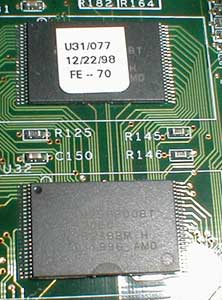 |
|
|
|
|
|
|
Flash Ram - Home to the OS
I have found the Home of where they are hide'n the Linux Kernel, its on redundant AMD Flash Ram chips. Don't know their size cause I cant get access to the OS, but its a nice way to put the kernel in an area that cant be harmed. This will greatly lower the RMA and repair turn around time on these devices ( thinking from a mfg's perspective). I confirmed these were redundant through a contact at Maxtor ( the guy worked at Quantum and now for Maxtor).
|
|
|
|
|
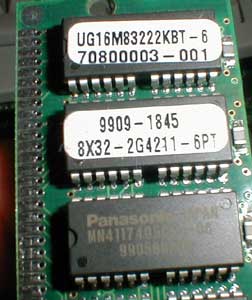 |
|
|
DRAM
Man just when I was getting away from EDO and FPM.. here it comes again. This is 60ns FPM SIMM ram.. 72 pin for those who don't know anything but 168Pin Dimms. This is a 32mb Simm ( 8x32), I USED to have a qty of 64mb Simms (16x32) around here but have long since sold them off. Let this be a lesson, you can never be too much of a computer gear packrat, you never know when you will need that EGA video card, or that AdLib Sound card. :)
|
|
|
|
The Chipset is ALi and DOES support large disks. That was my biggest worry when wanting to upgrade this device. I didn't want to put a 40GB drive on and find out it only could see 8.4GB ( since its from 1998 many BIOS and Chipsets could not handle over 8.4GB without a disk manager.) But that turned out to not be an issue. The Speed IS an issue though. This machine does not support any type of Ultra ATA, this is strictly PIO Mode (I don't know what mode though).
The Ethernet is Intel 10/100 Pro Nic. It is one of the better and most up to date features of the machine ( just cause Ethernet technology doesn't become obsolete too fast).
|
|
Hacking Cut Short:
|
|
|
There is a serial Header on the board, I have gone through almost EVERY pinout possibility ( Via Multi Meter to see which lines are which to eliminate some possibilities). NOTHING. I was really hopping that I would be able to access a serial console to start to work the OS over a bit. If ANYONE has the proper pin out for that header PLEASE E-mail me.
With this in mind I went on with just trying to upgrade the disks and see what the OS does. So lets get onto making a mountain of storage out of this mole hill of a device.
|
|
|
|
|
The Upgrade, Can it be done?  |
|
|
|
| Random Forum Pic |
 |
| From Thread: hmm; anyone know easy way to convert pre atx case? |
|
| | ProCooling Poll: |
| So why the hell not? |
|
I agree!
|
 67% 67%
|
|
What?
|
 17% 17%
|
|
Hell NO!
|
 0% 0%
|
|
Worst Poll Ever.
|
 17% 17%
|
Total Votes:18Please Login to Vote!
|
|






 Hack a Snap Server
Hack a Snap Server
 from 2 Readers
Must Log In to Rank This Article
from 2 Readers
Must Log In to Rank This Article
